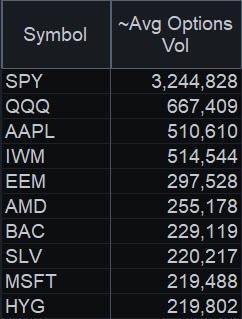Last weekend, TradeStation’s education team hosted a knowledge-packed training event on options. It was a great opportunity for someone like me, a perennial stock trader, to learn more about calls and puts.
In case you missed it, I took notes. Here are some of the key lessons from the Options Stars conference.

In the Money Options Have Less Risk
Most of the speakers emphasized the risk of buying out-of-the-money (OTM) options. These are contracts with no intrinsic value, whose strike prices are further away from the stock’s current level.
While many novices like OTM options because they’re cheap, they can lose value a lot more quickly if the underlier doesn’t move in your favor. That’s why the instructors favored calls and puts that are either in the money (ITM) or at the money (ATM). They might not have as much potential leverage but they’re less likely to expire worthless. You get what you pay for.
Liquidity is King
One drawback of options is that they can sometimes have poor liquidity. That means wide bid/ask spreads result in higher costs.
Poor liquidity can be a big problem with options because the difference may represent more than half the premium! The instructors taught this wide pricing generally occurs at the level of the underlying company and not just the individual contract. Some stocks have liquid options, and some don’t.
Many underliers are obvious, and the most active. For example:
- SPDR S&P 500 ETF (SPY): Pretty much the busiest symbol in the whole market. It’s also the most heavily traded name in the options market, and tends to have very tight bid/ask spreads.
- Apple (AAPL): The tech giant is routinely among the top names for options traders.
- Bank of America (BAC): The country’s No. 2 lender trades more than triple the options of larger rival JPMorgan Chase (JPM).

As a result, traders should identify those underliers with tight bid/ask spreads. They should then focus their options trades on that list. That was a key message across all the sessions.
Students were also encouraged to use limit orders as a way to avoid overpaying. Limit orders can sometimes even capture a price inside the bid/ask spread, which means you’re saving money.
Simple Is Beautiful
Despite having decades of combined experience between them, the instructors like to keep their trading simple. Every method they taught was easy to understand because they used no more than two or three indicators.
After all the real success is found in a trade’s risk/reward structure. A consistent track record matters a lot more than complexity. Simple is often the most beautiful — especially because it can be the easiest to replicate.
Another lesson was not to get too buried in the weeds with “Greeks.” The most important one is Delta, or the amount an option tracks the underlier.

Journaling Holds You Accountable
Finally, the Options Stars instructors pushed the absolute importance of accountability. Few of us would go back to a dentist who damaged our teeth or a mechanic who ruined our cars. Yet how often do traders go back to losing strategies?
The first step toward fixing this problem is to keep a journal. There’s no substitute for being honest with yourself.























